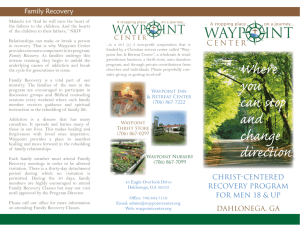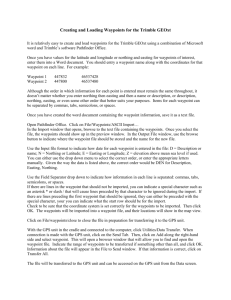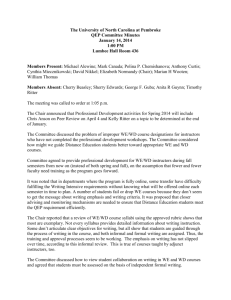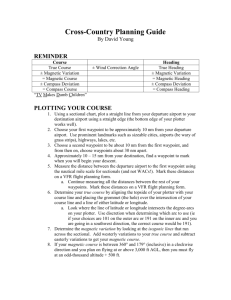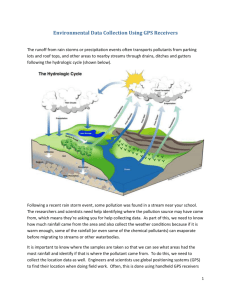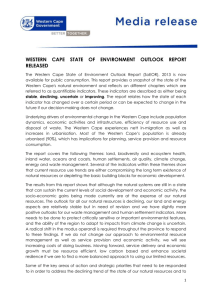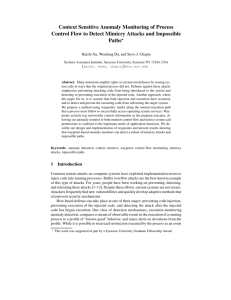Nat_veg_CFNR23Aug06 - University of the Western Cape
advertisement
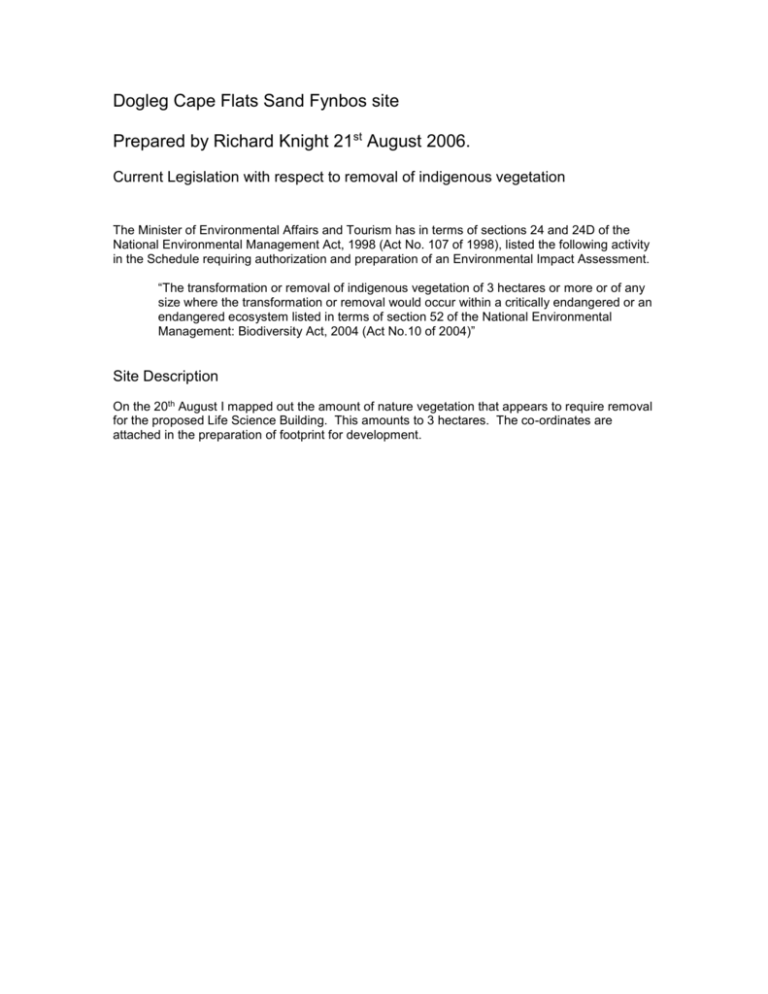
Dogleg Cape Flats Sand Fynbos site Prepared by Richard Knight 21st August 2006. Current Legislation with respect to removal of indigenous vegetation The Minister of Environmental Affairs and Tourism has in terms of sections 24 and 24D of the National Environmental Management Act, 1998 (Act No. 107 of 1998), listed the following activity in the Schedule requiring authorization and preparation of an Environmental Impact Assessment. “The transformation or removal of indigenous vegetation of 3 hectares or more or of any size where the transformation or removal would occur within a critically endangered or an endangered ecosystem listed in terms of section 52 of the National Environmental Management: Biodiversity Act, 2004 (Act No.10 of 2004)” Site Description On the 20th August I mapped out the amount of nature vegetation that appears to require removal for the proposed Life Science Building. This amounts to 3 hectares. The co-ordinates are attached in the preparation of footprint for development. Figure 1: Area of natural Cape Flats Sand Fynbos on the University of the Western Cape Campus, north of the access road and the site for the proposed Life Science Building. The footprint is 3 hectares, of which two is considered to be in good condition and the rest is restorable. Table 1: Coordinates defining area of natural Sandplain Fynbos on the University of the Western Cape Campus, north of the access road and the site for the proposed Life Science Building. The footprint area represents 3 hectares. Waypoint 1: Waypoint 2: Waypoint 3: Waypoint 4: Waypoint 5: Waypoint 6: Waypoint 7: Waypoint 8: Waypoint 9: 18° 37' 30.6” E, 18° 37' 30.6” E, 18° 37' 29.0” E, 18° 37' 28.1” E, 18° 37' 28.6” E, 18° 37' 28.1” E, 18° 37' 28.1” E, 18° 37' 28.3” E, 18° 37' 28.5” E, 33° 55' 50.0" S 33° 55' 53.7" S 33° 55' 54.6" S 33° 55' 55.7" S 33° 55' 56.7" S 33° 55' 56.7" S 33° 55' 56.8" S 33° 55' 57.1" S 33° 55' 57.1" S Waypoint 10: 18° 37' 28.9” E, Waypoint 11: 18° 37' 29.5” E, Waypoint 12: 18° 37' 30.2” E, Waypoint 13: 18° 37' 30.5” E, Waypoint 14: 18° 37' 31.9” E, Waypoint 15: 18° 37' 31.3” E, Waypoint 16: 18° 37' 29.8” E, Waypoint 17: 18° 37' 29.1” E, Waypoint 18: 18° 37' 28.3” E, Waypoint 19: 18° 37' 27.5” E, Waypoint 20: 18° 37' 26.6” E, Waypoint 21: 18° 37' 26.3” E, Waypoint 22: 18° 37' 26.9” E, Waypoint 23: 18° 37' 27.3” E, Waypoint 24: 18° 37' 27.7” E, Waypoint 25: 18° 37' 28.1” E, Waypoint 26: 18° 37' 26.6” E, Waypoint 27: 18° 37' 23.7” E, Waypoint 28: 18° 37' 23.7” E, 33° 55' 58.0" S 33° 55' 58.5" S 33° 55' 58.6" S 33° 55' 59.6" S 33° 56' 1.5" S 33° 56' 1.8" S 33° 56' 1.5" S 33° 56' 1.2" S 33° 56' 1.2" S 33° 56' 1.1" S 33° 56' 1.3" S 33° 56' 0.7" S 33° 56' 0.1" S 33° 55' 59.9" S 33° 55' 59.5" S 33° 55' 59.4" S 33° 55' 58.0" S 33° 55' 54.5" S 33° 55' 54.5" S The area is described as Cape Flats Sand Fynbos in terms of the City of Cape Town Biodiversity Strategy, and one of my roles was to help develop this strategic priority site mapping exercise and from this develop a spatial model that optimized the conservation options. Mr Barrie Low and myself developed a proposed re-construction of vegetation types of the City of Cape Town based on geology, rainfall and topography. From this analysis and the City of Cape Town perspective it can be seen that Cape Flats Nature Reserve comprises two vegetation type, namely Cape Flats Dune Strandveld on the more calcerous soils and Cape Flats Sand Fynbos on older and more acidic soils. Figure 2: Demarcation of the vegetation types with part of the University of the Western Cape campus for the Biodiversity Prioritization report for the City of Cape Town. The area of natural vegetation that will need to be removed for the proposed Life Science Building is marked and is clearly identified as Cape Flats Sand Fynbos, a habitat that is critically endangered due to its high level of loss through human activity and its low level of conservation protection which is currently 1/10th of the IUCN recommended protection by area. Endangered/Endemic Species The Cape Dwarf Chameleon (Bradypodion pumilum) has been observed in the Cape Flats Nature Reserve and is an endangered species, and its phylogeny is complex since it appears to have several forms (subspecies) that are habitat specific. Some of these forms appear to be restricted to our two most critical and endangered habitats, namely West Coast Renosterveld and Sandplain Fynbos. Figure 3: A male Cape Dwarf Chameleon (Bradypodion pumilum), an endangered species with forms (subspecies?) that are habitat specialist in Sandplain Fynbos and have been observed in the natural vegetation of the University of the Western Cape’s grounds. Floristic Survey An independent specialist report on the natural vegetation should be undertaken, probably using Doug Jeffery Environmental Consultants. The site is extremely rich in species as compared the main Cape Flats Nature Reserve. It is especially rich in geophytes (bulbs), restios and sedges. Soil Survey The area is a transition between alkaline dunes (pH 7.8) to highly acidic sands with a pH of 5.8. No other site on campus provides this same transition of environmental conditions and contributes to its relative high biodiversity. Conclusion Based on the information available it appears that proposed new Life Science building will require removal of 3 hectares of natural vegetation that is “critically endangered” and consequently the development will require environmental authorisation from a “competent authority and in respect of which the investigation, assessment and communication of potential impact of activities” as prescribed in regulations 22 to 26 of the environmental impact assessment regulations, 2006, promulgated in terms of section 24(5) of the act.” This act was implemented on the 3rd July 2006, and also has a clause than any existing development proposal that were being processed under the old legislation will be liable under the new environmental impact assessment regulations. “All applications in terms of the previous regulations received after the date of commencement of the NEMA EIA regulations, where the activities applied for are DEA&DP NEMA EIA Regulations Guideline & Information Document Series Guideline on Transitional Arrangements (July 2006) listed in terms of the NEMA EIA regulations, will need to be processed under the provisions of the NEMA EIA regulations. These applications will have to be resubmitted on the appropriate application forms in terms of the new NEMA EIA regulations. Applications that do not comply with the NEMA EIA requirements will be rejected and returned to the applicant.
